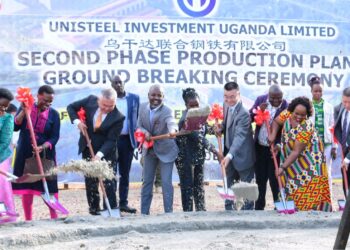By Denis Jjuuko
Earlier this September, Apple Chief Executive Tim Cook waltzed the stage at the Steve Jobs Theatre in California to unveil the company’s latest gadgets; the iPhone8, the iPhone8 Plus, and the iPhone X. The iPhone X is one of the world’s most expensive mass-market smartphones (forget those that are pimped with precious metals and gemstones). Generally, Apple products aren’t known to be cheap. They are, however, known to be of very high quality.
The iPhone or MacBook symbolizes class, style, and sophistication. They aren’t just a status symbol, they are efficient as well. However, Apple doesn’t own a manufacturing plant anywhere in the world. If you have any Apple product, at the back of it there is a little inscription: Designed by Apple in California. Assembled in China. After the design, Apple and its affiliates source parts from many companies and have their products assembled at Foxconn in China. Foxconn is one of the world’s biggest electronic contract manufacturers.
And if the epitome of class — the iPhone and MacBook that are the holy grail of smartphones and computers are made in China, there must be something good about that country’s technology and production processes.
Yet there is belief that Chinese products are fake and not long lasting. There might be a grain of truth in that. Most times, Ugandan importers bring into the country the worst of the products in order to maximize on profitability. Some of the clothes sold in downtown Kampala are actually disposable ones — wear once and throw away. This, however, is not an accurate representation of what the Chinese have got to offer.
Made in China generation
It is not only Apple that makes its high end products in China. Lots of other companies do. Nike, General Electric, Ford, General Motors among hundreds of other global giants either own factories in China or outsource Chinese companies for contract manufacturing. This means that the Chinese product isn’t the problem. The problem lies elsewhere. Traders who may want a quick profit or Uganda’s systems for quality control are very lax.
If you look at the construction industry in Uganda today, the Howo SinoTruck is becoming the most used dumping truck. The SinoTruck is slowly taking the market away from their Japanese, German, and Indian rivals. Howo SinoTruck is a brand owned by the Chinese automotive giant, China National Heavy Duty Truck Group (CNHTC).
By observing their dominance on the Ugandan market and given the poor road network of our country, the SinoTruck must be a very robust high quality vehicle. Ugandans have a tendency of not servicing vehicles. They prefer to repair them after they have completely broken down. They take literally the famous phrase “if it isn’t broken, don’t fix it.”

This further gives credibility to Chinese manufacturers. The Pioneer Buses that transport people in Kampala city, which are sometimes overloaded and battled by boda bodas and other reckless drivers are still on the road. Had their quality been so bad, they wouldn’t be on the road today. They must be easy to service too.
“Chinese manufacturers offer products that are competitive with foreign brands, but at a lower price. (It’s not just the Americans who are feeling the heat: Hyudai, Citroen and Kia sales are also down),” writes Michael J. Dunne, an authority on the automotive industry, in the July 2016 online issue of Forbes magazine.
The growth of the automotive sector in China — the world’s biggest car producer with 28.1 million units in 2016 — is giving renowned carmakers sleepless nights. “Chinese automakers are closing the perceived quality gap with mass-market foreign nameplates,” Dunne further observes.
China arrival
How did the Chinese get here? How did they have their brands, which were a few years ago laughing stocks respected? “Looking at China’s other industries gives us an ominous picture of the future for the automotive mass market. Chinese brands, once ridiculed as also-rans, today utterly dominate the TV, computer, cell phone, motorcycle, and home appliance markets,” Dunne argues.
In fact, Hisense, a consumer electronics maker now ranks number three in global TV sets shipment. They are even one of the major sponsors of the 2018 Fifa World Cup.
Huawei is now the second largest smartphone maker overtaking Apple in June 2017. It is currently positioning itself for a battle with South Korea’s Samsung for the number one spot. Lenovo, another Chinese company has arguably been the world’s largest personal computer vendor by unit sales since 2013.
All these examples point for a surge in the technological advancement of Chinese brands across the board. This may explain why Airbus has chosen China as the place to build its first wide-body jet plant outside Europe.
The aggressive move by the Chinese to become market leaders has seen them acquire global brands like Proton, Volvo, Pirelli and Lotus. It is also no secret that three Chinese companies are among the top 5 in the Fortune Global 500 list of 2017 with 109 Chinese companies featuring in the entire list, the second highest after United States at 132 companies.
Our business people instead of importing disposable clothes and low quality merchandise to shortchange consumers, should be looking at opportunities for partnership agreements with these Chinese brands. For example, why don’t they make the TV sets or mobile phones here? Such partnerships will create thousands of jobs and the much needed technology transfer to foster local content participation and economic transformation. That is the blueprint China used to develop its industries and become a world power in less than 40 years. It partnered with global players, learnt from them and built on that knowledge. We can do the same. We don’t have to reinvent the wheel.
The author is a media and communications consultant.
Twitter: @Denis_Jjuuko
Do you have a story in your community or an opinion to share with us: Email us at editorial@watchdoguganda.com











